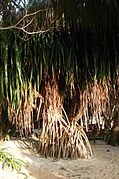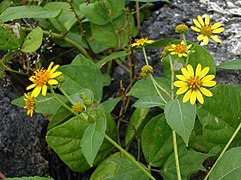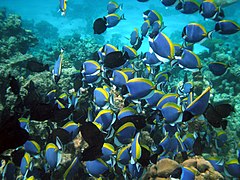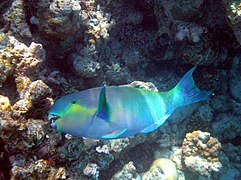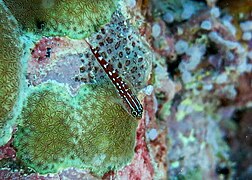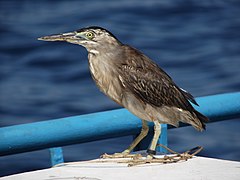Wildlife of the Maldives
The wildlife of the Maldives includes the flora and fauna of the islands, reefs, and the surrounding ocean. Recent scientific studies suggest that the fauna varies greatly between atolls following a north–south gradient, but important differences between neighbouring atolls were also found (especially in terms of sea animals), which may be linked to differences in fishing pressure – including poaching.[1]
Ecology
The land-based biotopes of the Maldives are highly endangered. The little land available in the country is being swiftly developed. Formerly uninhabited islands were only occasionally visited, but now almost no untouched uninhabited islands remain. Many of the natural habitats of local species have been severely threatened or destroyed during the past decades of development.
Coral reef habitats have also been damaged, as the pressure for land has brought about the creation of artificial islands. Some reefs have been filled with rubble with little regard for the changes in the currents on the reef shelf and how the new pattern would affect coral growth and its related life forms on the reef edges.
Plants

The Maldives have a rich variety of plant life despite the lack of fertile soils. There are three plant communities. The first is the foreshore, which is closest to the ocean and mostly bare except for hardy creeping vines such as
Mangrove forests
Mangroves are found in brackish or muddy areas of the Maldives. Fourteen species over ten genera are native to the Maldives, including one fern, Acrostichum aureum.[2]: 24
- Flora gallery
-
Pandanus fascicularis
-
Heliotropium foertherianum
-
Coconut trees
Vertebrates
Fish


There is a wide diversity of sea life in the Maldives, with corals and over 2,000 species of fish, ranging from colourful reef fish to the blacktip reef shark, moray eels, and a wide variety of rays: manta ray, stingray, and eagle ray. The Maldivian waters are also home to the whale shark. The waters around the Maldives are abundant in rare species of biological and commercial value, with tuna fisheries being one of the traditional commercial resources. In the few ponds and marshes there are freshwater fish, like milkfish (Chanos chanos) and smaller species. The tilapia or mouth-breeder was introduced by a UN agency in the 1970s.
- Sealife gallery
-
Whale shark (Rhincodon typus)
-
Powder-blue surgeonfish (Acanthurus leucosternon)
-
Threadfin butterflyfish (Chaetodon auriga)
-
Bullseye (Priacanthus hamrur)
-
Parrotfish (Scaridae)
-
Clownfish (Amphiprioninae)
-
Redtail butterflyfish (Chaetodon collare)
-
Spotted eagle ray (Aetobatus narinari)
-
Maldives Blenny (Ecsenius minutus)
-
Threefin Blenny (Helcogramma maldivensis)
Reptiles and amphibians

Since the islands are very small, land-based reptiles are rare. There is a species of
In the sea there the green sea turtle (Chelonia mydas), hawksbill sea turtle (Eretmochelys imbricata) and leatherback sea turtle (Dermochelys coriacea), that lay eggs on Maldivian beaches. Sea snakes such as the yellow-bellied sea snake (Hydrophis platurus) that live in the Indian Ocean are occasionally cast up on the shore after storms, where they are rendered helpless and unable to return to the sea. Saltwater crocodiles (Crocodylus porosus) have also been known to reach the islands and dwell in marshy areas.
The
Birds

The location of this Indian Ocean archipelago means that its avifauna is mainly restricted to
- Birds
-
Striated heron (Butorides striata)
-
Common sandpiper (Actitis hypoleucos)
Mammals
There are very few land mammals in the Maldives. Only a flying fox and a shrew[citation needed] are endemic.
Bringing dogs to the Maldives is strictly forbidden.[6]
In the ocean surrounding the islands there are several species of
Invertebrates

Corals
The islands of the Maldives themselves have been built by the massive growth of
Coelenterata
There are many kinds of anemones and jellyfish in Maldivian waters.
Arthropods
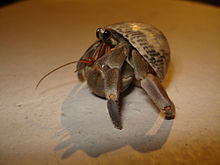
There are four species of lobsters and many species of crabs in the Maldives. Some crabs live in the water, but many, like the ghost crab, live on the beach burrowing holes in the sand by the waterline. Fiddler crabs are common on muddy reef shelves.
Some prawns and shrimp live near the islands but are not fished commercially.
There is a kind of centipede, as well as millipedes, and a small scorpion.
Several species of spiders are found in the Maldives. Spiders exhibit remarkable affinity with those found in the southwestern coast of Indian mainland and
Mollusks
Octopuses, squids, and clams are common on Maldivian reefs. The giant clam (Tridacna gigas) is common on the reef shelf.
Echinoderms
The Maldive reefs teem with
See also
References
- South Pacific Commission.
- ^ ISBN 978-99915-59-11-7. Retrieved 2018-10-13.
- ^ Bloodsuckers common in Maldives. Environment News, Articles and Reports (Report). Maldives: Bluepeace. 2007.
- ^ Phillips, W.W.A. (1958). "Some observations on the fauna of the Maldive Islands: Part IV – Amphibians and reptiles". Journal of the Bombay Natural History Society. 55 (2): 217–220.
- ^ Phillips, W.W.A. (1963). "The birds of the Maldive Islands, Indian Ocean". Journal of the Bombay Natural History Society. 60: 546–584.
- ^ "Maldives customs, currency, & airport tax regulations details". IATA Travel Center (iatatravelcentre.com).
- Romero-Frias, Xavier(1999). The Maldive Islanders: A study of the popular culture of an ancient ocean kingdom. Nova Ethnographia Indica.
- ^ "Venomous black widow spider plagues Male' International Airport". Dhivehi Observer.
- ^ Ducarme, Frédéric (2015). Field observations of sea cucumbers in the north of Baa atoll, Maldives (PDF) (Report). Beche-de-mer Information Bulletin. Vol. 35. South Pacific Commission.
Sources
- Agassiz, A.E.(1903). The Coral Reefs of the Maldives. Cambridge, UK: Mus. Camp. Zool.: Mem.
- "Prof. Agassiz' expedition to the Maldives". The Geographical Journal. 1902.

